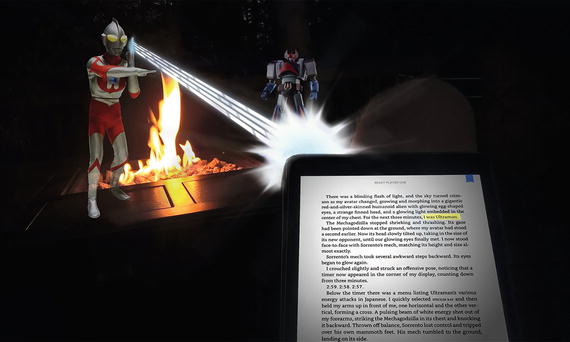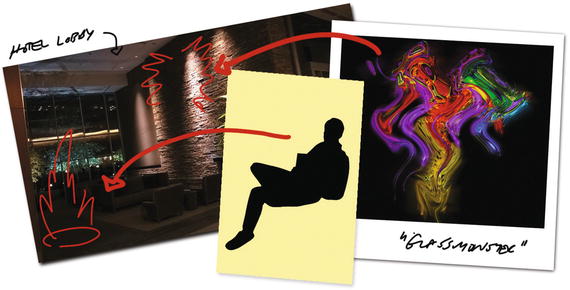Show me, don’t tell me.
Coming up with great ideas is relatively easy – gather a set of passionate people, set a goal, and before you know it you’ve got a whiteboard full of brilliance. You could probably rattle off several great ideas from just that one session. But, we all know bringing those amazing ideas to life is a completely different story. It’s incredibly hard work and always takes longer than anyone expects. There are so many aspects to define and details to figure out. How will it work? Look? Feel? Behave? Cost? How do you make it? The questions are endless.
As daunting as it is to answer all those questions up front, there is one aspect of early ideation that’s even harder to figure out – how do you motivate people to actually care about an idea?
Turns out, that’s precisely what envisioning is for.
Envisioning
helps people understand the potential of a new space by using whatever means works best to depict how the experience would feel.
Creating an emotional connection with a new idea matters more than what tech ends up being used or how the business model works. People need to feel something to act upon it.
The envisioning design methodology helps people transfer ideas from their mind’s eye to a tangible form others can see and experience. It makes your ideas and dreams real enough to show someone else in a convincing fashion, just as you do in other visual mediums. When done well, it exudes the feeling you’re after.
Envisioning can be done with words, pictures, actions, storytelling, animation, or any other way of communicating that’s capable of conveying emotion and feeling. It’s not necessary for these pieces to be executed perfectly in your medium of choice, but they do need to be impactful enough to make an impression, or even better cause a strong reaction – good or bad. Even pointed commentary and questions are a good sign.

Realistic sketches help people envision holograms acting out scenes from an eBook
In keeping with the goal of evoking a response, the shape envisioning takes and the method employed to accomplish it is nowhere near as important as the actual outcome it drives. The work we create to get our ideas across should be considered outlines, not finished pieces. Rough sketches are just as valuable as highly refined animations. No extra points are awarded for perfect form here. In fact, envisioning is often at its best when it appears more like a rough sketch than a polished cinematic masterpiece.
Just like prototyping, our work here should be thought of as disposable, all in the service of getting our message across and moving ideas forward.
Interestingly enough, working in this fashion helps us in several counterintuitive ways, as described in the following sections.
Poses Questions
Great envisioning poses more questions than it answers. And that’s a good thing.
In general, our design work is meant to answer questions not raise more. Yet, the more believably something is depicted, the more we need to know how it works, usually in great detail. Our minds fire with dozens of questions all at once when confronted with something just out of the norm. What if this or that? How does it work exactly? Could you do this other thing, too? It’s the same effect as when we see a phenomenally well-done motion picture. We are so absorbed in the narrative or the feeling it conjures that we temporarily suspend our disbelief just enough to see it as plausible.
The highest compliment a piece can receive is when someone argues emphatically that it can’t possibly work that way, citing a very specific reason. At that point, you have clearly captured their attention. It doesn’t matter whether they’re right or not – you have them engaged and challenging the vision.
In its simplest and most effective form, envisioning poses questions that help people recognize the potential for change and activates their curiosity.
You’ll also find that even seemingly noncontroversial pieces can generate questions about motive and message. Just as some of our greatest works of art serve as master provocateurs, so too can envisioned pieces. Use the envisioning process to help you kick off discussions about the vision, rationale, and even morals behind the pieces. Invite pointed questions through deliberate and purposeful choices in the work itself.
Getting people to engage and debate about a picture of possible futures is a good sign you have the right number of challenging elements present.
Tests Assertions
Turning ideas into tangible pieces helps test all the assertions we make consciously (or not) during our conceptualization and execution phases.
When ideas and dreams are made real enough to be viewed and debated by others, there’s a natural tendency to poke at the depiction and question what it is trying to represent. Intentionally or not, our work asserts certain things to be true, often unconsciously. Identifying those assertions is important to us gaining a deeper understanding and agreement on our direction and rationale.
Assertions come in two forms that we should pay attention to, but for very different reasons.
Explicit assertions are conscious choices made during creation. The shape something takes, its implied behavior, spatial alignment, and movement are all examples of aspects that can be purposely asserted. We make those unambiguous choices and build upon them throughout the piece. Those intentional choices we made will automatically be accepted or rejected by the viewer, helping us gauge how close we’re getting to our intended focus. It’s an easy way to measure progress.
Other assertions that are explicit but not done intentionally prove more interesting. Those choices are made subconsciously based on our experience and shared understanding of the larger world around us, or the specific situation we’re depicting. These unintentional items often go into the work unnoticed precisely because they are so natural or expected for the creator. Identifying and discussing these unintentional assertions is a great way for the team to double check things aren’t being taken for granted or that we’ve assumed too much from our intended audience.
Conversely, implicit assertions exist in plain sight, but are invisible.
Implicit assertions rely upon the viewer understanding our intent, even if key aspects of the situation are unexpressed. If you see something that looks like a dog, you assume it’s probably going to act like a dog based on your experience, even though there are no visible rules to that effect. We all have a shared understanding of how things act, work, and react (or not). The problem comes when our expectations are disrupted or broken by new behavior.
For example, if a human-like hologram appears to not be touching the floor when it first appears, we can assume the creator purposely meant it to float free of gravity, like a ghost. Right? No? Oh, it was just a mistake in the drawing or bug in the code? Got it. Not really a ghost, just a hologram misaligned with the environment. Easy mistake to make, but your audience would have mistakenly thought your hologram was intended to be a ghost. They implicitly realize floating objects are not bound by gravity like normal.
Identifying assertions in the things we envision helps us evaluate how well we’re communicating intent.
Understanding our implicit assertions is important as a Designer. It keeps us constantly thinking about unconscious bias and things we often take for granted about our work.
Envisioning can magnify our assertions early enough in the process that we have time to dig into them properly and decide how to proceed.
Creates Artifacts
The process of designing anything leaves traces of the methods used and steps taken to arrive at a particular place. These traces are sometimes the smallest of things – a quick sketch, words jotted down on a scrap of paper, even a text message sent to ourselves as a reminder. They come in all shapes and sizes, and vary in their degree of fidelity. These early fragments of our thoughts are combined during the creation process into pieces that form an artifact. Those in turn act as a historical record of the journey.

Artifacts trace our path through the envisioning journey
The envisioning method results in many valuable artifacts that contribute to learning how to better do things for the next set of ideas. Those artifacts help us retain concrete records of our path to the future. They also give us a set of landmarks to understand our direction and evolving thought process.
Removes Constraints
Envisioning is used to illustrate potential paths forward, but those paths don’t have to be realistic or even possible in the near term. And that’s the beauty in this type of design work: it pushes us forward toward new possibilities. It’s meant to be both aspirational and inspirational.
When envisioning holograms in these early days of the platform, the Designer is freed from the constraints of existing paradigms to explore the optimal ways of doing things without being pulled back by convention. That’s huge. Rarely do we have new mediums to explore in this way. However, that does come with its own challenges.
A key difference between working with holograms and other types of computing platforms is the lack of precedents (except for sci-fi movies). We don’t readily know what’s possible or even plausible in this space. That makes it difficult for some people to embrace what you’re going for with your designs. They can’t tell if you don’t understand the capabilities of the platform or are just painting a vision of what could be. That’s a real issue sometimes, but can be worked through using hints in the pieces themselves.
By using persuasive visuals, we can hint at entirely new capabilities and illustrate underlying concepts. We don’t need to perfectly visualize and exhaustively define things upfront to successfully communicate these breakthrough holographic concepts — just the opposite in fact. Because speed is the key to moving your early idea forward, doing a hand-drawn sketch or crafting a narrative about the feel of the experience you’re looking for is a great way to start making that connection with people, and opening their minds to the possibilities of an unconstrained creator’s palette. Hinting at capabilities in the envisioned piece is an invitation for discussion and debate.
The flood gates open when you find yourself designing unconstrained, so don’t slow down to consider if it’s plausible just yet. You’ll have many opportunities to refine and fill out the details of these initial explorations later. Keep exploring to capture more of those brilliant thoughts about where things could go.
Quickens Pace
Using envisioning early in the process to generate multiple directions and scenarios is a great way to set the pace for the rest of the project.
There’s no question a quickly scribbled vision of how your hologram interacts with people would not be as useful to your Developers as a digital motion study or a fully rigged 3D model. That said, with just a bit more effort than a quick doodle, you can effectively portray many aspects of what you are going for in a convincing manner that delivers a tangible, plausible, and inspiring image of what could be. Doing so will get your team locked in much sooner than a whiteboard sketch of a hand wavy interface, and avoids the long delay of creating high-quality studies or assets. If it looks real, it will be real in people’s minds. And that is where the real speed up comes from in the short term.
Making things real for your team enables them to accelerate quickly in their own roles.
Tells a Story
Marshalling support for innovative new ideas can sometimes be as easy as drawing the right picture or telling a compelling story. That’s the realm and role of envisioning. It brings our dreams to light in ways we couldn’t previously see or conceive of, and makes them real enough to inspire others to act.
